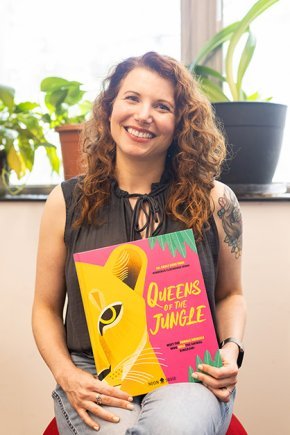
Queens of the Jungle
Lion moms, fish clones and lizards in love
Did you know elephant families are led by a matriarch who is usually the oldest and largest female in the group? They’re not the only ones. Some of nature’s fiercest predators – lions, hyenas, orcas – live in social groups led by females. A closer look throughout the animal kingdom reveals a wide array of species whose females show adaptations and behaviors that defy common expectations.

Carly York, Ph.D., associate professor of biology, has taken that closer look and compiled the findings in “Queens of the Jungle,” her second book exploring the natural world for young readers.
“Growing up with an understanding of the natural world and the animal kingdom is powerful, and you start the interest when you’re young. That’s where the spark comes from,” said York. “Whatever they do academically or professionally, if I can inspire someone to be curious about the world moving forward, in helping to preserve our world, then I feel like I’ve done a good job.”
As a specialist in science communication, York understands the importance of her academic credentials in establishing credibility and confidence with readers of all ages, but cataloging the quirks of the females of so many species presented a unique challenge.
“The things that make a lot of female animals awesome are often related to either mating or hunting behaviors – basically sex or murder, which isn’t exactly kid-friendly,” York chuckled. “I worked closely with my editors, and I think we hit the balance between really interesting and empowering information while keeping it age appropriate.”
York’s first book, “Horses (A Day in the Life): What Do Wild Horses like Mustangs and Ponies Get Up To All Day?” drew heavily on her experiences and observations living and working closely with horses throughout her life. “Queens of the Jungle” took York into new territory.

“I learned some new things in the course of writing this book. One of the species that was new to me was the Amazon Molly, which is just this little gray fish that’s an all-female species, that reproduces through parthenogenesis – which is genetically complicated but essentially means they clone themselves,” York shared.
One of York’s favorite species included in the book is the blanket octopus, whose females have flowing iridescent "capes" surrounding their tentacles. Another favorite is a small non-venomous reptile native to Australia – the shingleback lizard.
“Most animals are not monogamous. They’ll have multiple mates throughout their lifecycle, but shingleback lizards are monogamous in a really interesting way,” York explained. “They’ve mastered the long-distance relationship. So, they’ll get together during breeding season, then go their separate ways, and get back together when breeding season comes around again. They’ll keep this cycle going for 20 years or more.”
York is also in the editing stages of a book for adults, documenting strange and silly science experiments and their benefits. While there are obvious differences in the content she writes for adults and for children, York’s approach is similar for all audiences.

“Across the board, good science communication involves knowing your material really well so you can explain it in a way that anyone can understand,” she said. “Then you want to put it together in a package that gets people excited and interested. And with ‘Queens of the Jungle,’ I also hope it will be empowering for young girls to see there are plenty of examples in nature where females rule.”
“Queens of the Jungle” was released on May 28 by Neon Squid Publishing – a kid-focused nonfiction imprint of Macmillan Publishers – and is now available for purchase.

Beloved professor. Inspiring mentor. Joyful presence. Lenoir-Rhyne remembers Dr. Toni Smith Oakes, who shaped the heart and spirit of the OT program.
View More
Lenoir-Rhyne University students showcased their academic excellence and research expertise at the 2025 North Carolina Academy of Science (NCAS) annual meeting in late March.
View More